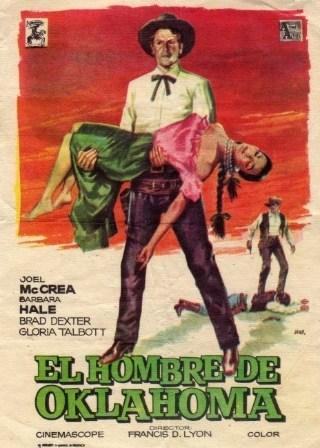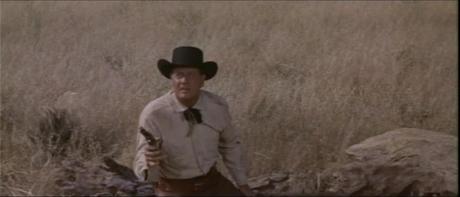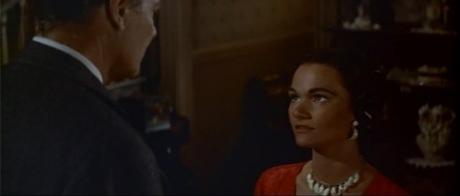
Allied Artists Pictures grew out of Poverty Row specialists Monogram and produced and distributed movies from the late 40s through to the 70s. The brainchild of Walter Mirisch, the studio aimed to produce what he termed B+ movies, promising a step up from the lower production values Monogram had been associated with. What resulted was a range of films from the instantly forgettable to the memorable, and everything in between. For this blogathon celebrating the work of the studio I’ve chosen a late 50s western, The Oklahoman (1957) starring Joel McCrea, one of the genuine icons of the genre. It’s a brisk tale of love, race and oil, charging home at just under 80 minutes and never pausing for breath.
It’s 1870 in the Oklahoma Territory and a couple of wagons bound for California have stopped off, the reason being that a baby is on the way. Tragically, the mother dies in childbirth and leaves the grieving father, John Brighton (Joel McCrea), with an infant girl and a tough choice to make. The experience has sapped his pioneering spirit and, being a doctor, he decides to stay put in the small town and set up in practice. We jump forward a few years and the child is growing up, reaching that stage where she needs a maternal figure in her life. Brighton finds himself in the enviable position of having two attractive women vying for his affections – the first is the young Indian girl, Maria (Gloria Talbott), he’s hired to look after his daughter, while the other is a widowed rancher, Anne Barnes (Barbara Hale). Thus we’re presented with a romantic triangle with the somewhat bemused doctor as the focal point. Westerns tend to use change as the engine to drive their dramatic content, sometimes it’s changes to the social structure or the spread of civilization and the establishment of the rule of law. In this case, the evolution of society is underway with the absorption of the native people into the community already in progress. That theme is addressed of course but there’s also the matter of shifting economic priorities at play, providing the motivation for the actions of the villains and in the process threatening to cast a shadow over the native-settler relationship. When leading rancher Cass Dobie (Brad Dexter) becomes aware of the large oil deposits on the neighboring land owned by Maria’s father (Michael Pate) he sees the direction the economic wind is blowing. If he can’t get the land by buying it, he’s quite prepared to resort to whatever means are necessary, regardless of who gets in his way or what social damage is caused.

While the oil angle is interesting and a little unusual for a western, it’s the treatment of the racial aspect which stands out particularly in this film. Right from the beginning the Indian characters are shown to be working at integration into white society and, even more notably, being accepted on those terms. The conflicts of the past haven’t been forgotten of course, as a conversation among a few town residents on the boardwalk one evening demonstrates, but they’re spoken of in a philosophical and progressive way – there’s an explicit admission of wrongdoing and an awareness that the fighting had justifications from both sides. What’s more, the question of racial tension only rears its head when the villains force it onto the agenda, and even then those who would seek to reopen old wounds and exploit the resulting hostility remain in the minority; there are as many and perhaps more voices expressing support for the Indians.
The Oklahoman came from the pen of Daniel B Ullman, who had a long list of writing credits to his name. Latterly, he wrote extensively for television but also contributed a significant number of western scripts, including Canyon River, Wichita, At Gunpoint and Face of a Fugitive, to name just a few. The cameraman was another vastly experienced guy, Carl Guthrie, and he helps give the whole thing a look which at least partially belies the modest budget. Director Francis D Lyon started out as an editor and did the bulk of his work for TV. His feature credits are limited (he did take charge of the rather nifty Escort West though) but he does fine with this movie and certainly keeps everything moving at pace.

All too often, the romantic elements can feel like a superficial adjunct, something bolted on to pad the running time or broaden the appeal of a movie. However, with The Oklahoman that’s not an issue; the romance, and the jealousies and confusion arising from it fold neatly into the plot and are integral to the picture. Joel McCrea plays what might be termed a typical McCrea role, that of a stolid and upright individual maneuvered by circumstance into a conflicted position. I think the key to McCrea’s success and enduring popularity among western fans is the smoothly professional way he handled such parts. As he aged he grew in courtliness and took on a more introspective air. That served him well in his scenes with both Gloria Talbott and Barbara Hale, the respectful reserve striking the right tone for a character who has long lived alone and has perhaps come to accept that his path is destined to lie in that direction – the gradual uncoiling of this stiffness adds a whole lot of charm and poignancy to the film. Brad Dexter had an unctuous quality to him, a slippery lack of sincerity, which again is used to good effect here. The ready smile is never any more than a paper-thin facade and you can almost see the self-absorbed computations going on behind it. In support there are nicely written parts for Michael Pate, Anthony Caruso, Verna Felton and Esther Dale. Furthermore, we get to see genre stalwart Ray Teal in a rare sympathetic role.
The Oklahoman is available on DVD in the US as part of the Warner Archive line and there’s also a European edition, which I own. The film is part of a 2-disc set from Spain, paired up with Jacques Tourneur’s Wichita. The transfer is good enough without being especially noteworthy. Presented in anamorphic scope and boasting generally strong colors, it can look a bit soft from time to time but is in reasonable shape for all that. The disc is a very basic one with no extra features whatsoever and the Spanish subtitles are optional and can be disabled either through the setup menu or on the fly via the remote. I’m very fond of these short, punchy westerns from the late 50s and anything with Joel McCrea in the lead ought to be recommendation enough in itself. Check it out, if you get the chance.
This piece is offered as part of the Allied Artists Blogathon hosted by Toby at 50 Westerns from the 50s. I’d like to suggest readers visit the site and check out the other contributions to this blogathon dedicated to the films of Allied Artists by following the link above. Alternatively, feel free to click on the badge below, which will take you to the same destination.

